Family Ties
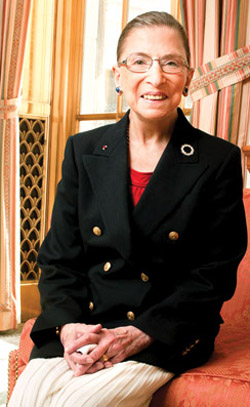
Photo by Sam Kittner
It’s ironic that being a parent was what made law school easier for Ruth Bader Ginsburg. For a woman in 1950s America, motherhood was held out as the reason that she shouldn’t even have been there.
“I think my life was more balanced,” says Justice Ginsburg of her years as a student at Harvard and Columbia law schools. “I was less apprehensive than my classmates because there was something going on that was more important, frankly, than the law.”
In an interview at the U.S. Supreme Court in August, Justice Ginsburg talked about her career as a lawyer and judge; about marriage to her late husband, Martin; and about the changes that women have seen in law and parenthood.
Confirmed for the court in 1993, Ginsburg, now 77, became the second female justice, joining Justice Sandra Day O’Connor. With Justices Elena Kagan and Sonia Sotomayor, the court now has three women.
But friends and colleagues say that understanding Justice Ginsburg and her insistence on gender equality begins with her relationship to her husband and children. Their marriage—and the sharing of expectations and parenting responsibilities—impelled both Ginsburgs to achieve.
“One of the things that’s really dramatic about Justice Ginsburg is that her husband was always very proud of her career, and willing to support her,” says Joan C. Williams, a professor at the University of California’s Hastings College of the Law in San Francisco, who also co-directs the Project for Attorney Retention and directs the Center for WorkLife Law. “Many men, then and now, have the sense that unless their wives take the second seat and support their own careers, they’ll never get to the heights they seek.”
“That’s my dream for the world,” says Ginsburg, who has two children and four grandchildren. “That a child should have two caring parents who share the joys and often the burdens. It really does take a man who regards his wife as his best friend, his equal, his true partner in life.”
HIGH EXPECTATIONS
For a lawyer who advanced the cause of women’s rights—in court and in her life—that belief formed the basis of what Ginsburg says feminism is all about.
“It takes women and men who are feminists. By feminists I mean people who think women should have equal chances to do whatever their talent permits them to do,” she says. “They have to be willing to ask for these accommodations. It’s more than asking—it’s expecting how workplaces should be organized.”

Podcasts: Stephanie Francis Ward talks to Ruth Bader Ginsburg about her gender discrimination cases and balancing career and family.
Brooklyn born, Ginsburg gained acceptance to Harvard Law School in 1956, two years after her marriage to Martin. In 1958 she transferred to Columbia Law School to join Martin, who graduated from Harvard a year earlier and took a job at New York City’s Weil, Gotshal & Manges as a tax attorney.
Unlike today, when there are many child care choices —including worksite day care programs—when Ginsburg transferred to Columbia there were only two nursery schools in the New York area, she says, and the children could stay no more than three hours a day.
“When I was in grade school she was one of the very few mothers in my class who worked,” says Ginsburg’s daughter, Jane Ginsburg, now an intellectual property professor at Columbia Law School. “I remember a friend of mine telling me that her mother said she ‘had to be nice to Jane because Jane’s mommy worked.’ Like I had leprosy or something.”
Unlike many female lawyers from her generation, Ginsburg didn’t pause her career to raise children, initially because she didn’t feel she had a choice. When Martin was in his third year of law school he was diagnosed with advanced testicular cancer, and he spent most of his spring semester recovering from surgery and taking radiation treatments.
“I didn’t have any break because frankly we didn’t know how long Marty was going to live, and I might end up being the sole supporter of Jane,” says Ginsburg, who lost her mother, Celia Bader, to cancer in 1950, eight years before her husband’s diagnosis.
“By the time we were out of the danger zone and it was past the five-year mark of his surgery, I was so hooked on my job that I would not give it up,” she adds.
Nevertheless, Ginsburg says she found time to raise her children. In fact, she says, “I attribute to my daughter the responsibility for why I was such a good law student. I went home, played with Jane, had dinner and then I was ready to go back to the books. It was the pause that refreshes.”
Ginsburg was selected to both the Harvard and Columbia law reviews. And despite being tied for first place in the Columbia class of 1959 and earning a glowing recommendation from the dean of Harvard Law School, Supreme Court Justice Felix Frankfurter refused to hire her as a clerk. She got a job clerking for Judge Edmund L. Palmieri of the U.S. District Court for the Southern District of New York.
When the clerkship ended Ginsburg worked for the Columbia Law School Project on International Procedure, and in 1963 she joined the Rutgers Law School faculty. While there she co-founded the Women’s Rights Law Reporter, the first U.S. law journal to focus solely on women.
She also started taking gender discrimination cases on behalf of the American Civil Liberties Union. One of her clients was Stephen C. Wiesenfeld, a widower whose wife died in childbirth. He challenged the Social Security rule that allotted child care benefits to women whose husbands died, but denied them for men who lost their wives. His wife, Paula Polatschek, was a schoolteacher and had provided most of the couple’s income before her death.
Wiesenfeld wrote to a New Jersey newspaper about his experience. A Rutgers professor saw the published letter and brought it to Ginsburg.
“He was told he couldn’t get the child care benefit, and he said, ‘Why? I have a child in my care,’ ” she says. The case, Weinberger v. Wiesenfeld, worked its way to the U.S. Supreme Court, which in 1975 found that widowers and widows with minor children are entitled to Social Security benefits when a wage earner dies.
ADDRESSING EQUAL PAY
In 1972 Ginsburg joined the law school faculty at Columbia, and she founded and agreed to serve as director of the Women’s Rights Project of the ACLU.
One of Ginsburg’s early interests pertained to faculty salaries. While at Rutgers, Ginsburg discovered that her salary was lower than those of her male colleagues. She took part in a class action lawsuit against the university that was later settled.
Later, Ginsburg persuaded fellow Columbia female employees to challenge the retirement plan offered by the Teachers Insurance and Annuity Association—College Retirement Equities Fund, which paid women lower monthly retirement benefits. TIAA-CREF said it relied on mortality tables that showed women usually live longer than men. Statistics revealed that women and men summed the same amount of money, but life expectancy spread the amount differently.
“That’s what stereotypes are,” Ginsburg says. “They are true in the majority of cases. But they are not inevitably true, and why should people be boxed in who don’t conform to the stereotype?”
Between 1973 and 1979, while teaching, running the Women’s Rights Project and raising two children, Ginsburg argued six cases in the U.S. Supreme Court.
“She’s extraordinarily thorough and very composed in the way she presents things. What I learned from her was that these were issues she was totally committed to, and she would be very aggressive pursuing them,” says Joseph Levin, a Montgomery, Ala., lawyer and a co-founder of the Southern Poverty Law Center. Levin was counsel of record for Sharron Frontiero, a U.S. Air Force lieutenant who was denied housing and medical benefits for her husband, Joseph.
At the time, servicemen automatically got benefits for their wives by claiming them as dependents. But service women had to prove their husbands were dependent on them for more than half their support.
On behalf of the Women’s Rights Project, Ginsburg submitted an amicus brief supporting Frontiero. It was the first case she argued in the Supreme Court.
“The discrimination [Frontiero] encountered was the most typical. It was the assumption that if a woman is a wage earner, she earns it for herself,” Ginsburg says. “Women were automatically assumed to be dependents, and men were the responsible breadwinners.”
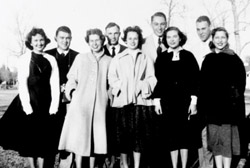
Ruth Bader Ginsburg stands in front of her husband, Martin, (far right) with a group at Artillery Village in Fort Sill, Okla., in November 1954 after Martin was drafted into the Army. Photo courtesy of the collection of the Supreme Court of the United States.
In 1973, the Supreme Court found in Frontiero v. Richardson that the military benefit policy was unconstitutional because there was no reason wives needed benefits more than husbands in similar situations. The case changed the standard for gender-related cases, with the plurality arguing for strict judicial scrutiny, rather than rational basis review.
All of Ginsburg’s Supreme Court cases involved gender discrimination, and Frontiero was the only one that had a female plaintiff. Showing discrimination against both genders was part of the Women’s Rights Project strategy.
“One of her favorite things to do was to always show the double-edged sword of everything,” says Brenda Feigen, a Los Angeles lawyer who worked with Ginsburg on Frontiero when both were employed by the Women’s Rights Project. “She had a flair for knowing what kind of nonlegal but relevant social and historical facts needed to be put into a brief to get the justices to understand.”
CHANGING WITH THE TIMES
In the 1970s the country was changing rapidly, Ginsburg notes, and that offered much material for brief writing. “We emphasized that discrimination begins with women as wage earners. We recognized in the briefs that if you did a poll, yes, most people divided their lives that way—most women took care of home and children, and most men earned bread,” she says. “But more and more people had lives that didn’t conform to that pattern, and shouldn’t the law be neutral in people’s choices?”
In the mid-1970s Ginsburg stopped using the term sex discrimination to describe her cases. A secretary at Columbia prompted the decision. The woman typed all of Ginsburg’s speeches and briefs and noticed that the word sex popped out “all over the page.”
“ ‘Don’t you know that to the audience you are addressing, mostly men of a certain age, the first association with the word sex is not what you’re talking about?’ ” Ginsburg recalls the secretary observing. She suggested that Ginsburg use a neutral term.
“It won’t make as distracting associations,” Ginsburg adds. “I thought that was such a good insight.”
Ginsburg looked to desegregation cases for ideas on how to build up case law, but convincing the court and the public of your position was different, she says. Most people understood issues of race, but not necessarily those of gender.
“Most men in the 1970s thought that the law differentiated between men and women, but it was always benignly in women’s favor,” she says, mentioning her last Supreme Court case, Duren v. Missouri. The defendant, who was convicted of first-degree murder and robbery, argued that a state law exempting women from jury duty on request violated his Sixth Amendment rights to an impartial jury.
When the Supreme Court granted cert, Lee Nation, then a Kansas City, Mo., public defender, selected Ginsburg as his co-counsel.
“We were trying to explain that [the exemption] was not a favor to women. It certainly wasn’t a favor to women plaintiffs, or women defendants in criminal cases,” Ginsburg says. “The system was saying that you are expendable; we didn’t need to participate in the administration of justice.”
The Supreme Court overturned Duren’s conviction in 1979 and remanded the case to trial.
Nation was 25 years old when he argued the case, and he selected Ginsburg as co-counsel because he remembered reading about her work on the Frontiero case while he was in law school.
Shortly before oral arguments he went to New York City to prepare and stayed at the Ginsburgs’ apartment, sleeping in one of the children’s rooms. Nation notes that besides prepping for the case, he was a young man in a big city, enjoying himself.
“She was teaching at Columbia then, and she’d say, ‘Lee, I think you should go to the library and study today,’’ he says.
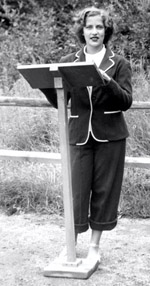
Displaying leadership qualities at an early age, Ruth Bader delivers a sermon as camp rabbi in 1948 at Che-Na-Wah camp in Minerva, N.Y. Photo courtesy of the Collection of the Supreme Court of the United States.
“The other thing I remember: I was sitting around with Ruth one night drinking wine, and she was real curious about what it was like to be a big-city public defender, with murder and drugs,” says Nation, who now practices with the Prescott, Ariz., office of Goldberg & Osborne. “She was genuinely interested in all that.”
In 1980 President Jimmy Carter appointed Ginsburg to the U.S. Court of Appeals for the District of Columbia Circuit. Marna Tucker, a name partner with Washington, D.C.’s Feldesman Tucker Leifer Fidell, was on the president’s nominating commission.
“She’s extremely articulate and well-spoken on any issue she opens her mouth about,” says Tucker, who also knew Ginsburg through the American Bar Association.
When Ginsburg got to Washington, Tucker says, many saw her as reserved. If you were seated next to Ginsburg at a dinner party, Tucker recalls, a good way to make small talk was to ask her about her children or the law.
“I don’t get a sense that she’s shy anymore. I think she’s very comfortable with her role on the U.S. Supreme Court and who she is as a person now,” Tucker says. “I always find that if I give her an idea, and she’s excited about it, she’ll just keep going and talk and talk. It’s very helpful. And when Ruth smiles, she has this grand, grand smile. Her whole face lights up.”
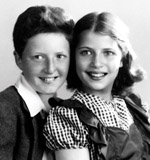
Bader with her first cousin Richard Bader, circa 1943. Photo courtesy of the collection of the Supreme Court of the United States.
WORK-LIFE BALANCE
As with her legal work, Ginsburg’s sense of gender equality traces to her family. She would occasionally take her son, James, who was born in 1965, to events.“One of her former students remembers Ginsburg bringing him to faculty gatherings at Columbia and said they’d never seen a child that active in their life,” says Jane S. DeHart, a history professor at the University of California at Santa Barbara who is working on a biography of Ginsburg.
James, now founder and president of the Chicago classical music label Cedille Records, attended the Dalton School in his youth.
“He was always getting into pranks—nothing really bad—and the headmistress would call, demanding a conference with his mother,” DeHart says. “At one point Ginsburg said, ‘This boy has a father—call him,’ and instructed the school to alternate calls between herself and her husband.”
Once the school started contacting Martin Ginsburg, James says, the calls were much less frequent.
“I got into trouble a lot, but the first thing they called him about was actually pretty ridiculous, and he was not shy about showing them his opinion of the matter,” says James, who grew up playing Scrabble with his mom. As a boy, James says, he loved math, and he also liked to talk, so much that he got the moniker “motormouth.” On walks across town with his mother, she would give him complicated math problems to solve in his head.
“That would give her the peace and quiet she needed,” James says.
“They were warm parents, and from what I observed I didn’t hear a lot of fretting and obsessing about kid things and teenage things that I certainly heard from a lot of parents,” says Kathleen Peratis, who worked with Ginsburg at the Women’s Rights Project and is now a partner with New York City’s Outten & Golden.
“And she cared a lot about what she called the ‘home work gap.’ It was really the way she viewed gender inequity problems,” says Peratis, explaining that “home work” was how Ginsburg described household and child care tasks.
Work blended with home life as well. Jane Ginsburg remembers her mother often working until 4 a.m.
“She’d consume an entire pot of coffee, starting at midnight,” she says. During car trips to her father’s golf club or to visit family on Long Island her mother was always reading, often advance sheets.
As a high school student, Jane read and edited her mother’s briefs.
“I have many memories of her writing briefs in the cases that went to the Supreme Court. Largely [she was concerned] about good writing. She would work very hard on writing clear sentences,” Jane says. “Dinner table conversations were almost always about her cases.”
Says Justice Ginsburg: “Marty and I decided that, barring something really important, we would be home and have dinner with the children every night.” She also admits that cooking is not her forte. Dinner, by her hand, was usually frozen vegetables and grilled meat that had been defrosted. Once a teenager, Jane took over the task with her father, who was known as a masterful cook.
Given the technology available today, Ginsburg is surprised that more lawyers with young children aren’t telecommuting.
“I would think it should be easier, not harder, today to accommodate home and family life,” she says. When she visited her husband at Weil, she noticed lawyers coming in and going out of the office during the day, which seemed to her a waste of time.
“It takes time to break old ways of thinking,” Gins burg adds. “I had to be economical with my time; I didn’t have hours of time to waste.”
Culture was also important, and when Jane was small, most weekends were spent visiting exhibitions and children’s shows.
“My initial response to Jane was I wanted to enrich her in every way I could, so I overdid it. I was compensating for my having a job,” Ginsburg says.
When Jane was an infant, Ginsburg and her husband, who handled half of the baby feedings, included music in the routine. “He’d always put something beautiful on the Victrola because he wanted her to associate food with beautiful music. Jane grew up loving both,” says Ginsburg, who loves opera.
When Jane was 8, Ginsburg took her to the Metropolitan Opera to see Mozart’s Così Fan Tutte.
“It was at the old Met. We sat in the first row of the balcony so she would have no heads to look over,” Ginsburg says, adding that she had a velvet jumper made for the occasion, which Jane wore with new patent-leather shoes.
“I wanted her to remember it as something special. We started playing the record months ahead of time, and when the music was familiar I sat down and we went through the libretto, so she knew all the lines,” Ginsburg says. “She loved it.”
Jane Ginsburg says her mother is “good with kids, because she’s never particularly dramatizing with kids.” And her minute attention to detail that was often commented on by colleagues and former clerks was present at home, too.
“Even now I’m really quite amazed that she did all these things. Not just in the work arena. For instance when I went to sleep-away camp she wrote regularly,” Jane says. “She just sort of has this way of being meticulous and attending to detail that in a way is quite daunting to even think about keeping up with.”
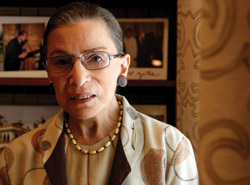
Photo by Associated Press.
INSPIRATION BY EXAMPLE
In 1993 President Bill Clinton nominated her to succeed Justice Byron White. She was confirmed that same year.
Albert F. Cacozza Jr. was one of her clerks on the D.C. Circuit. He attended the Senate Judiciary Committee hearings with her, along with Ginsburg’s husband, children, son-in-law, soon-to-be daughter-in-law and two of her grandchildren, who were then young children.
Cacozza notes that if Ginsburg felt pressured, it was relieved when Martin Ginsburg entered the room. “They were just a team. Marty was a very accomplished guy, and there was not one ounce of jealousy or envy. There was none of that,” says Cacozza. Then single with no children, the Ginsburg partnership left a strong impression on him, he says.
A tax lawyer and Georgetown Law School professor, Martin Ginsburg died of cancer this summer, a few days after the couple’s 56th wedding anniversary. He was often described as one of the country’s best tax attorneys. Many who knew the couple say his admiration and support for his wife, coupled with their determination to share home responsibilities, played a large role in Gins burg’s success, both as a parent and a lawyer, and define who she is today.
In fact, when Ginsburg received her nomination to the Supreme Court, it appeared that no one was more excited than Martin Ginsburg.
“You’ve got to share; that’s the lesson I took from it,” says Cacozza, who now has two children, 18 and 15. “I was very involved in the lives of my kids. It’s not something where my wife is supposed to take care of everything.”
Female clerks have similar memories. “She gave me a picture of the kind of career that was possible with children, that I’d want to have,” says Abbe R. Gluck, a professor at Columbia Law School who clerked for Ginsburg in 2003. Gluck is the mother of 4-year-old twin boys.
“After clerking with her I felt I was not going to be in a job that prevented me from being an excellent lawyer or an excellent mother,” Gluck says. “I thank her for giving me that determination. It’s not impossible, and women shouldn’t stop trying.”
In August, Ginsburg told the Associated Press that her work helps her cope with the loss of her husband, and she has no immediate plans to retire.
“It’s great for this institution and for the country that women are now one-third of the highest court in the land,” Ginsburg says.
“It means that we are really here. We are no longer one- or two-at-a-time curiosities.”
Correction
The print and initial online version of the October article about Justice Ruth Bader Ginsburg's early career ("Family Ties") stated that "Ginsburg discovered that her salary was lower than those of her male colleagues. She took part in a successful equal-pay campaign with other women who taught at Columbia." Ginsburg joined a class action lawsuit involving pay at Rutgers, not Columbia. Also, Albert F. Cacozza Jr. was one of her clerks on the D.C. Circuit, not the 2nd Circuit.The ABA Journal regrets the errors.



